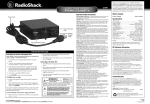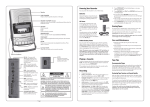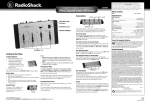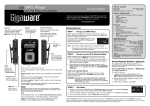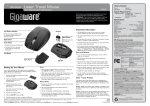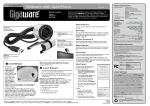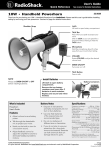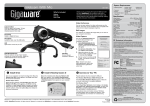Download Radio Shack 21-1703 A User`s guide
Transcript
21-1703 A Mini Mobile CB Radio Downloaded from www.cbradio.nl Thank you for purchasing your Mini Mobile CB Radio from RadioShack. Please read this user’s guide before installing, setting up and using your new product. What’s Included CB Radio 3mm Self-tapping Screw (2) Microphone Spring Washer (2 big + 4 small) Holder Plain Washer (2 big + 4 small) Mounting Bracket Nut (2 big + 2 small) 5mm Machine Screw (2) Mounting Knob (2) 3mm Machine Screw (2) Rubber Washer (2) 5mm Self-tapping Screw (2) User’s Guide Contents Product Features......................................................................... 3 Setup.......................................................................................... 4 Attaching the Microphone Holder.....................................................4 Mounting the Transceiver...................................................................5 Connecting an Antenna......................................................................6 Connecting the Microphone ..............................................................7 Connecting an External Speaker ......................................................7 Using Vehicle Battery Power..............................................................8 Using the Transceiver ............................................................................... 8 Operation.................................................................................... 9 Receiving Transmissions and Adjusting Squelch...........................9 Transmitting.........................................................................................9 Selecting the Emergency Channel ...................................................9 Operational Hints ............................................................................. 10 Common Uses for CB Radios .................................................................10 Transmission Courtesy ............................................................................10 Using Common 10-Codes ............................................................... 10 Maximum Range.............................................................................. 11 Additional Information............................................................... 12 Troubleshooting................................................................................ 12 Reducing Noise ................................................................................ 12 Care and Service .............................................................................. 13 Replacing the Fuse .......................................................................... 13 6SHFLÀFDWLRQV ................................................................................... 14 RF Emissions Information .............................................................. 15 Limited Warranty ............................................................................. 16 2 Product Features Product Features Push to Talk (PTT) Microphone Channel Display Shows the current channel. CHANNEL Rotate to select frequency. VOLUME Rotate to increase or decrease the speaker volume. OUT CH9 CH19 Switch to move between standard frequencies and emergency channels. TX / RX Shows when the radio is transmitting (TX), or receiving (RX). SQUELCH Rotate to adjust the amount of background noise. Other Features Full Legal Power – gives you the greatest available range. Automatic Noise Limiter – reduces impulse-type noises while receiving. External Speaker Jack – provides a connection for an external speaker. Phase-Locked Loop (PLL) Frequency Synthesizer – provides highly accurate and stable tuning. Two Built-In Ceramic Filters – ensure superior channel selectivity and freedom from adjacent channel interference. Automatic Modulation Control – prevents the transmitter signal from overmodulating and distorting. 3 Setup Setup Attaching the Microphone Holder You can attach the microphone holder to either side of the transceiver or to another location in your vehicle. To attach the holder to either side of the transceiver, secure the holder to the side using the supplied 3mm self-tapping screws, and spring washers. Holder Spring washer 3mm self-tapping screw To attach the holder to another location in the vehicle, such as the dashboard, follow these steps. 1. Using the holder as a template, mark the positions for the mounting screw holes at the desired location. 2. At each marked position, drill a hole slightly smaller than the supplied mounting screws. 3. Attach the holder at the mounting location using the supplied 3mm machine screws, spring washers, plain washers, and nuts. Note: If you cannot reach behind the mounting surface to attach the nuts on the machine screws, use the supplied 3mm plain washers and self-tapping screws. 4 Setup Mounting the Transceiver Cautions: • If you use this CB in a vehicle, mount it securely to avoid damage to the CB or vehicle, or injury to anyone in the vehicle during sudden starts or stops. • Do not mount the CB where it could damage or interfere with the operation of any passive restraint safety device (an airbag or seat belt). • Be careful not to drill into objects behind the mounting surface. If you are mounting the CB in a vehicle, choose a location where: • You can easily reach the CB. • Wires and cables are clear of the vehicle’s pedals or other moving parts. • The CB is not directly in front of heating vents. • All wires and cables can reach their connection points. The most common mounting location for this CB is under the vehicle’s dashboard. However, if you plan to use the CB as a base station, you can place it on a desk, shelf, or table (see “Using the Transceiver” on p.8). To mount the CB under your dashboard: 1. Using the supplied mounting bracket as a template, mark the positions for the screw holes on the mounting surface. 2. At each marked location, drill a hole slightly smaller than the supplied mounting screws. 3. Mount the bracket to the mounting surface with the supplied 5mm machine screws, spring washers, plain washers, and nuts. 4. Attach the CB to the bracket using the supplied rubber washers and mounting knobs. Note: If you cannot reach behind the mounting surface to attach the nuts on the machine screws, use the 5mm self-tapping screws and plain washers to secure the bracket. Mounting bracket Mounting knob 5 Setup Connecting an Antenna There are many different types of CB radio antennas for mobile CBs. Each type has its own benefits, so choose the one that best meets your needs. Note: If you are using this CB as a base station, see “Using the Transceiver” on p.8. Once you choose an antenna, follow its mounting instructions. Then route the cable to the transceiver and connect the cable to the ANTENNA jack on the back of the transceiver. For the antenna’s best performance, you should mount the antenna: • as high as possible on the vehicle • as far as possible from sources of electrical noise • vertically EXT SPEAKER jack ANTENNA jack To take advantage of your CB’s maximum range, you can adjust the antenna’s standing wave ratio (SWR) using an SWR meter (not supplied). Follow the instructions supplied with the SWR meter and antenna to adjust your antenna’s SWR to the lowest possible value. SWR values of 2.0:1 are generally acceptable, with readings of 1.5:1 or lower being more desirable. Cautions: • Avoid routing the cable next to sharp edges or moving parts, which might damage the cable. • Do not run the cable next to power cables or other CB antenna cables. • Do not run the cable through the engine compartment or other areas that produce extreme heat. 6 Setup Connecting the Microphone 1. Press the tab on the side of the supplied microphone’s plug and insert the plug into the MIC jack on the front of the transceiver. Be sure the tab is aligned with the jack’s notch. Notch Tab 2. Slide the microphone onto the microphone holder. To disconnect the microphone from the transceiver, press the tab on the side of the plug. Then pull out the plug. Caution: To avoid damaging the microphone,, never pull on the microphone cable. Connecting an External Speaker Your transceiver also can be connected to an external CB speaker (not supplied). Note: When you connect an external speaker, the CB’s internal speaker disconnects. The external speaker you use with the transceiver should have an impedance of 8 ohms and be able to handle 3 to 10 watts of power. The speaker cable must have a 1/8 -inch (3.5mm) plug. Your local RadioShack store carries a variety of speakers and cables to meet your needs. To connect the external speaker to the transceiver, insert the speaker cable’s plug into the EXT SPEAKER jack on the back of the CB. 7 Setup Using Vehicle Battery Power To connect the transceiver to the vehicle battery power: 1. Connect the red wire (with the inline fuse holder) on the back of the transceiver to a point in your vehicle’s fuse block that has power only when the ignition is in the ACC (accessory) or ON position. 2. Connect the black wire to a metal part of the vehicle’s frame (chassis ground). Caution: Do not connect the black wire to a non-metallic (plastic) part, or to any part insulated from the vehicle’s chassis by a nonmetallic part. Using the Transceiver Negative (–) black wire Positive (+) red wire Although this transceiver is designed mainly for mobile use, you can also use it as a base station with an AC power source. For base station installation, you need these items (not supplied): • a 13.8V DC power supply that can supply at least 1.5 amps • base station antenna • coaxial antenna cable and connector Warning: Use extreme caution when you install or remove a base station CB antenna. If the antenna starts to fall, let it go! It could contact overhead power lines. If the antenna touches a power line, contact with the antenna, mast, cable, or guy wires can cause electrocution and death. Call the power company to remove the antenna. Do not attempt to do so yourself! Follow these steps to install the CB as a base station. 1. 2. 3. 4. 5. Mount the base station antenna as described in its owner’s manual. Connect the antenna to the ANTENNA jack on the back of the CB. Connect the transceiver’s black power wire to the negative (–) terminal on the DC power supply. Connect the transceiver’s red wire to the positive (+) terminal on the DC power supply. Connect the DC power supply to a standard AC outlet. Caution: Most 13.8V DC power supplies plug into a standard AC outlet to produce DC power. Before connecting your CB to a 13.8V DC power supply, read and follow the instructions included with the power supply. 8 Operation Operation Receiving Transmissions and Adjusting SQUELCH 1. 2. 3. 4. 5. 6. 7. Rotate SQUELCH fully counterclockwise. Rotate VOLUME clockwise until it clicks to turn on the transceiver. The channel display lights and the channel appears, and the RX indicator lights. Set OUT CH9 CH19 to OUT if you want to select a channel other than an emergency channel. Rotate the channel selector until the display shows the desired channel. Adjust VOLUME to a comfortable listening level. To cut out background noise between transmissions, wait until there is no signal, then slowly rotate SQUELCH clockwise until the background noise stops. To turn off the CB, rotate otate VOLUME counterclockwise until it clicks. The display and indicators turn off. Note: To receive very weak signals, turn SQUELCH counterclockwise. You will hear noise between transmissions, but you will also hear weak transmissions (those not strong enough to break through a higher squelch setting). Transmitting Follow steps 1 – 5 in “Receiving Transmissions and Adjusting SQUELCH”. To transmit, hold down PUSH TO TALK (PTT) on the microphone and speak. The TX indicator lights. Release PUSH TO TALK when you finish transmitting. The TX indicator turns off. To turn off the CB, rotate VOLUME counterclockwise until it clicks. The display and RX indicator turn off. Selecting the Emergency Channel Important: Channel 9 is reserved for motorist assistance and for reporting emergency information about accidents, hazardous road conditions, and so on. Always give emergency messages priority on Channel 9. To select the emergency Channel 9, set OUT CH9 CH19 to CH9. The selected channel number flashes on the display. Channel 19 is used by truck drivers for general communication purposes. To select this channel, set OUT CH9 CH19 to CH19. To select another channel, set OUT CH9 CH19 to OUT. The previously selected channel number appears on the display. 9 Operation Operational Hints Common Uses for CB Radios • Warn of traffic tie-ups ahead. • Help truck drivers and delivery personnel learn road and traffic conditions and get assistance in locating destinations. • Provide fast help in the event of emergency or breakdown. • Help construction crews coordinate the activities of different work crews. • Assist communication between security officers. • Provide weather and road information. • Contact friends or other CB users on road trips. • Keep in touch with your office or home. • Bring more fun for camping, fishing, and other sports; help locate a friend or find out what’s cooking back at camp. Transmission Courtesy • Wait for a pause in someone else’s transmission before you ask for a break. • If you do not receive an answer to your call after a second attempt, sign off and wait several minutes before trying again. • Do not hold down PTT when you are not talking. (This is called dead keying.) • Assist callers with directions, information about road conditions, and any other reasonable request. Using Common 10-Codes Citizen’s band operators and users have largely adopted the 10 codes for standard questions and answers. These codes permit faster communication and better intelligibility in noisy areas. 10 Operation This table lists codes adopted by the Associated Public Safety Communications Officers (APCO) Code Meaning Code Meaning 10-1 Your signal is bad. 10-17 En route. 10-2 Your signal is good. 10-18 Urgent. 10-3 Stop transmitting. 10-19 Contact ___. 10-4 Message was received and understood. 10-20 What is your location? 10-21 Call ___ by telephone. 10-5 Relay information to ___. 10-22 Cancel last message. 10-6 I am busy. OR Are you busy? 10-23 ___ arrived at the scene. 10-7 Out of Service. 10-24 ___ assignment complete. 10-8 In Service. 10-25 Meet ___. 10-9 Repeat last message. 10-26 Estimated time of arrival is ___. 10-10 Negative (NO). 10-30 Use caution. 10-11 ___ in service. 10-31 Pick up. 10-12 Stand by. 10-33 10-13 Report road / weather conditions. Emergency traffic. Clear the channel. 10-34 What time is it? 10-14 Information. 10-41 Switch to channel ___. 10-15 Message delivered. 10-62 ___ cannot understand. 10-16 Reply to message. Maximum Range The maximum range and quality of CB transmissions vary depending on the following conditions: • the type and quality of antenna used • the height of the antenna’s mounting location—the higher the antenna, the better the signal’s range • the surrounding terrain—mountains and tall buildings limit the range • weather conditions • the number of nearby CBs operating on the same channel • standing wave ratio (SWR) between the antenna and the CB. 11 Additional Information Troubleshooting If your CB is not working as it should, follow these suggestions to see if you can eliminate the problem. If you cannot, take the CB to your local RadioShack store for assistance. Symptom Check/Try CB has trouble receiving. Turn the transceiver power on. See “Operation” on p. 9. Secure connections (antenna, microphone). Adjust squelch. Radio may not be on an operating channel. Switch to an active channel. PUSH TO TALK may be held down. Release PTT. Adjust the volume. CB has trouble transmitting. Turn the transceiver power on. Secure connections (antenna, microphone). Check for corrosion in connections. Clean and tighten connections. Radio may not be on an operating channel. Switch to an active channel. PUSH TO TALK is not firmly pressed down. Press PTT completely. The CB does not work at all. Secure connections. The fuse may need replacing. See “Replacing the Fuse” on p. 13. Channels cannot be selected. Set OUT CH9 CH19 to OUT. PUSH TO TALK is held down. Release PTT. Reducing Noise Because the CB itself is fairly quiet, most noise you hear is probably from an external source in your vehicle such as the alternator, another CB, or spark plugs. The transceiver uses an ANL (Automatic Noise Limiter) circuit to reduce noise. However, if possible, try to eliminate the noise by finding its source. You can determine the noise’s source by turning off the engine and operating the CB with your vehicle’s ignition set to ACC. If the noise is reduced, the problem is in your vehicle’s ignition or electrical system. Here are a few hints to help you reduce or eliminate such noise. 12 Additional Information • Make all CB power and antenna wires as short as possible. • Route the power wires away from the antenna wires. • Be sure that the chassis ground connection is secure. • Replace old ignition wires with new, high-voltage, noise suppression wires. • Install noise suppressors on your spark plugs, or install new spark plugs that have built-in noise suppressors. • If problems persist, check your vehicle’s alternator/generator and regulator gauges. You can reduce the noise from these sources by using bypass capacitors at the various output voltage points. Your local RadioShack store has a wide selection of noise suppression accessories. Care and Service Keep the CB dry; if it gets wet, wipe it dry immediately. Use and store the CB only in normal temperature environments. Handle the CB carefully; do not drop it. Keep the CB away from dust and dirt, and wipe it with a damp cloth occasionally to keep it looking new. If your CB is not performing as it should, take it to your local RadioShack store for assistance. To locate your nearest RadioShack, use the store locator feature on RadioShack’s web site (www.radioshack.com), or call 1-800-THE-SHACK (843-7422) and follow the menu options. Modifying or tampering with the CB’s internal components can cause a malfunction and might invalidate its warranty and void your FCC authorization to operate it. Replacing the Fuse The CB’s 2-amp in-line fuse helps protect your CB from power surges and short circuits. When replacement is required, use a 2-amp, slow-blow glass fuse (not supplied). 1. Make sure the power source and CB are both off. 2. Hold the fuse holder by both ends, push the ends together, twist one end, and pull them apart. 3. Remove the old fuse and inspect its condition. If it is blown, insert a new one of the same type and rating. If it is not blown, reinsert it. 4. Push the fuse holder ends together and twist one end. 13 Fuse Fuse holder Additional Information Specifications Receiver Frequency coverage ............... all 40 CB channels (class D) 26.965 - 27.405 MHz Sensitivity for 10 dB S/N ................................................................................ 0.6 μV Tight squelch limit ............................................................................. 350 - 2820 μV Overall audio fidelity for 450 - 2500 Hz ......................................................... -6 dB Maximum audio output power ................................................................... 6 watts Cross modulation ........................................................................................... 50 dB Transmitter Frequency coverage ............... all 40 CB channels (class D) 26.965 - 27.405 MHz Frequency tolerance ................................................................................ ±1300 Hz Carrier power at no modulation ................................................................. 4 watts Spurious emission ......................................................................................... -67 dB Current drain at no modulation ............................................................... 1300 mA Modulation frequency response for 450 – 2500 Hz ..................................... -6 dB Microphone sensitivity for 50% modulation .................................................. 2 mV General Power requirements .................................................. 13.8V DC, negative ground Dimensions (H×W×D) .................... 13/8 × 4¼ × 57/8 inches (35 × 108 × 150 mm) Weight ............................................................................................ 1 lb 6 oz (640 g) Included accessories .............................. microphone hanger, mounting bracket Specifications are typical, individual units might vary. Specifications are subject to change and improvement without notice. 14 Additional Information RF Emissions WARNING! The Federal Communications Commission has adopted a safety standard for human exposure to radio frequency electromagnetic energy emitted by FCC regulated transmitters. It is up to the user to properly operate this radio transmitter to ensure safe operation. Please adhere to the following: Never allow children to operate the radio without adult supervision and the knowledge of these guidelines. Avoid touching the antenna when transmitting. Do not use the radio with a damaged antenna. Please contact your local RadioShack store for a suitable replacement. Use only the supplied accessories to comply with FCC RF exposure requirements. For more information about RF exposure, please visit the FCC web site at www.fcc.gov. The Federal Communications Commission (FCC) does not require you to have a license to operate this CB. However, the FCC does require that you read and know Part 95 of FCC Rules. These rules apply to the operation of a Class D CB. We have provided a copy of these regulations with your CB. Do not open your CB to make any internal adjustments. Any internal adjustments can be made only by an authorized service technician. Unauthorized internal adjustments and/or modifications can lead to illegal operation as defined by Part 95 of FCC rules. Such illegal operation can lead to very serious consequences. Your CB might cause TV or radio interference even when it is operating properly. To determine whether your CB is causing the interference, turn off your CB. If the interference goes away, your CB is causing it. Try to eliminate the interference by either moving your CB away from the receiver or contacting your local RadioShack store for help. If you cannot eliminate the interference, the FCC requires that you stop using your CB. If you cannot eliminate the interference, contact your local RadioShack store for help. This device complies with Part 15 of the FCC Rules. Operation is subject to the following two conditions: (1) this device may not cause harmful interference, and (2) this device must accept any interference received, including interference that may cause undesired operation. 15 Limited Warranty This product is warranted by RadioShack against manufacturing defects in material and workmanship under normal use for one (1) year from the date of purchase from RadioShack company-owned stores and authorized RadioShack franchisees and dealers. EXCEPT AS PROVIDED HEREIN, RadioShack MAKES NO EXPRESS WARRANTIES AND ANY IMPLIED WARRANTIES, INCLUDING THOSE OF MERCHANTABILITY AND FITNESS FOR A PARTICULAR PURPOSE, ARE LIMITED IN DURATION TO THE DURATION OF THE WRITTEN LIMITED WARRANTIES CONTAINED HEREIN. EXCEPT AS PROVIDED HEREIN, RadioShack SHALL HAVE NO LIABILITY OR RESPONSIBILITY TO CUSTOMER OR ANY OTHER PERSON OR ENTITY WITH RESPECT TO ANY LIABILITY, LOSS OR DAMAGE CAUSED DIRECTLY OR INDIRECTLY BY USE OR PERFORMANCE OF THE PRODUCT OR ARISING OUT OF ANY BREACH OF THIS WARRANTY, INCLUDING, BUT NOT LIMITED TO, ANY DAMAGES RESULTING FROM INCONVENIENCE, LOSS OF TIME, DATA, PROPERTY, REVENUE, OR PROFIT OR ANY INDIRECT, SPECIAL, INCIDENTAL, OR CONSEQUENTIAL DAMAGES, EVEN IF RadioShack HAS BEEN ADVISED OF THE POSSIBILITY OF SUCH DAMAGES. Some states do not allow limitations on how long an implied warranty lasts or the exclusion or limitation of incidental or consequential damages, so the above limitations or exclusions may not apply to you. In the event of a product defect during the warranty period, take the product and the RadioShack sales receipt as proof of purchase date to any RadioShack store. RadioShack will, at its option, unless otherwise provided by law: (a) correct the defect by product repair without charge for parts and labor; (b) replace the product with one of the same or similar design; or (c) refund the purchase price. All replaced parts and products, and products on which a refund is made, become the property of RadioShack. New or reconditioned parts and products may be used in the performance of warranty service. Repaired or replaced parts and products are warranted for the remainder of the original warranty period. You will be charged for repair or replacement of the product made after the expiration of the warranty period. This warranty does not cover: (a) damage or failure caused by or attributable to acts of God, abuse, accident, misuse, improper or abnormal usage, failure to follow instructions, improper installation or maintenance, alteration, lightning or other incidence of excess voltage or current; (b) any repairs other than those provided by a RadioShack Authorized Service Facility; (c) consumables such as fuses or batteries; (d) cosmetic damage; (e) transportation, shipping or insurance costs; or (f) costs of product removal, installation, set-up service adjustment or reinstallation. This warranty gives you specific legal rights, and you may also have other rights which vary from state to state. RadioShack Customer Relations 300 RadioShack Circle, Fort Worth, TX 76102 12/99 www.radioshack.com Protect the environment by recycling used electronics. Go to www.ecyclingcentral.com to find a recycling location near you. ©2008. RadioShack Corporation. All rights reserved. RadioShack and RadioShack.com are trademarks used by RadioShack Corporation. 21-1703 A P/N: AO0309AAA1 06A08 Printed in China

















